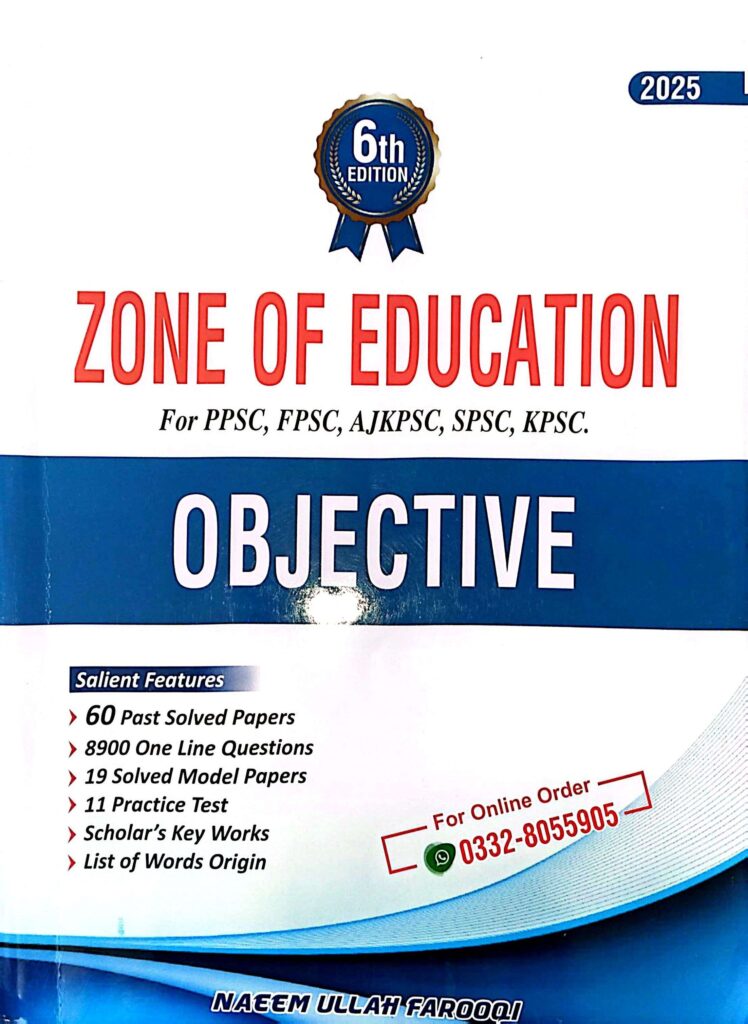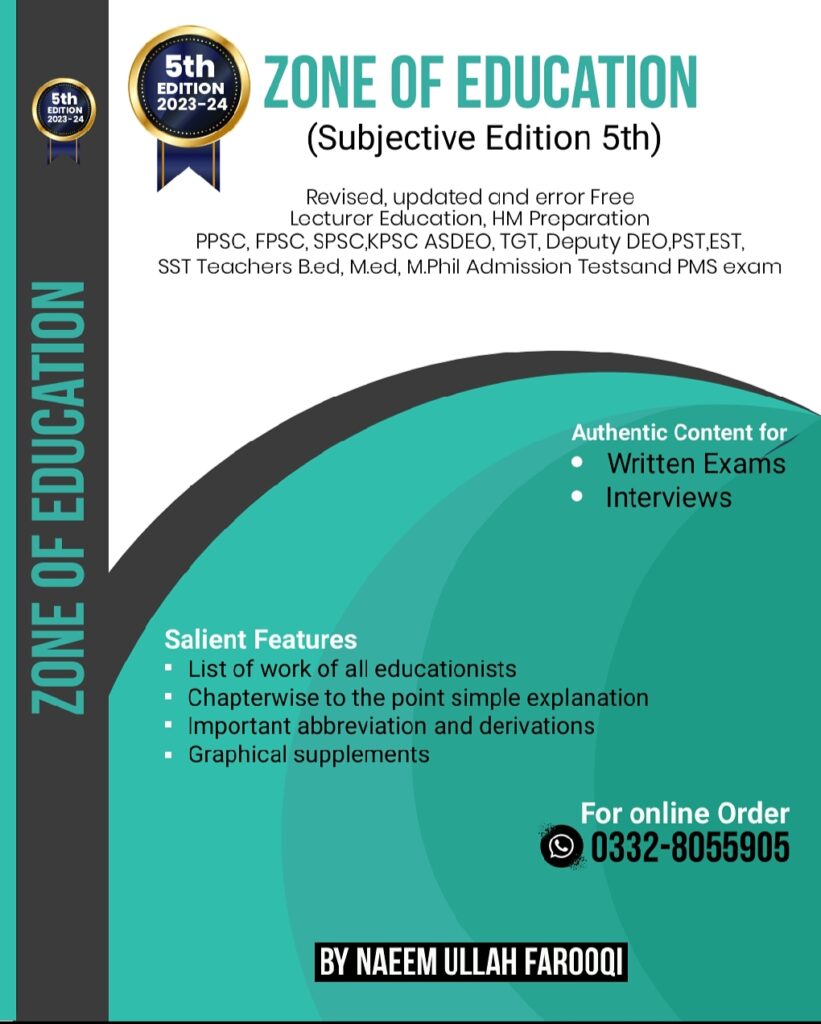PAST PAPER (HEADMASTER/HEADMISTRESS) SPSC
.18. S.N.E is an abbreviation of
a. Schedule of new experience
b. Schedule of new entry
c. Schedule of new expenditure
d. System of new entry
19. Budgeting is an estimation of
a. Income and investment
b. Investment
c. Income and expenditure
d. Income, investment, expenditure
20. Private educational institutions were nationalized under
a. Education conference 1947
b. National education commission 1959
c. National educational policy 1970
d. National educational policy 1972
21. Under national education policy 1972, free education was recommended up to class
a. 5 b. 12
c. 10 d. 18
22. Intelligence level of gifted students is
a. 140 and above b. 110
c. 90 d. 80
23. The____________ is sum of total activities that a school offers to influence child learning
a. Course b. Curriculum
c. Outline d. Syllabus
24. Curriculum development refers to the total process of curriculum
a. Designing
b. Designing and implementing
c. Designing and evaluating
d. Designing, implementing, evaluating
25. Who recognized that students construct knowledge based on their experience?
a. Locke b. Piaget
c. Skinner d. Vygotsky
26. Education is the development of sound mind in a sound body is said to by
a. Plato b. Piaget
c. Skinner d. Aristotle
27. In millennium development Goals (MDGs) the Goal 2 is related to
a. Child Mortality b. Poverty
c. Universal primary education
d. Environmental sustainability
28.________________ is the idea that knowledge comes from experience
a. Rationalism
b. Deductive reasoning
c. Logic
d. Empiricism
29. _____________ tests focus on information acquired through informal learning that goes on in life
a. Personality b. Achievement
c. Aptitude d. Intelligent
30. the most frequently occurring number in set of value is called the
a. Means b. Median
a. Mode d. Range
31. UNESCO has proposed that a developing country must spend on education sector
a. 1% of GNP b. 2% of GNP
c. 3 % of GNP d. 4% of GNP
32. Bloom taxonomy has following domain
a. Affective b. Cognitive
a. Psychomotor d. Cognitive, Affective, Psychomotor
33. The Lowest level of cognitive domain is
a. Application b. Knowledge
c. Synthesis d. Evaluation
34. The teacher is considered in the world
a. Social agent b. Political agent
c. Change agent d. Religious agent
35 Micro –teaching is a technique that is:
a. Content oriented b. Skill oriented
c. Assessment oriented
d. Discipline oriented
36. Educational psychology is the study of
a. Mental illness
b. Learners, learning and teaching
c. Intelligence
d. Cognitive process
37. When it comes to applying learning theory to the classroom, the most pressing problem for educators is
a. Getting students to learn
b. Presenting students with the right stimuli on which to focus their attention and mental effort
c. Finding age-appropriate learning materials
d. Presenting the learning materials in gender-neutral manner
38. In planning instruction, what 3 components are essential to incorporate?
a. Learning theory, subject matter, and particular student development level
b. Ways to integrate music, art and as many of the other disciplines as possible
c. Technology theories, graphic and seatwork
d. Computer assisted learning
39. Classroom instructional methods such as cooperative learning and project-based learning and discovery derive from the theories of:
a. Piaget b . Thorndike
c. Vygotsky d. Plato
40. Motivation:
a. Reside only in students who are pay attention
b. Is an external process
c. Is innate
d. Is an internal process
41 If an achievement test measures what it says it measures, the test is said to be:
a. Reliable b. Valid
c. Normative d. Error free
42. The ratio of one’s mental age (MA) to one’s chronological age (CA) is known as:
a. Standardized test
b. Mental test
c. Intelligent Quotient (IQ)
d. Aptitude test
43 A student who has difficulty in maintaining attention because of a limited ability to concentrate may be diagnosed with
a. Attention deficit hyperactivity disorder (ADHD)
b. Down syndrome
c. Mental retardation
d. Autism
44. Students are more likely to be intrinsically motivated when they have a sense of self
a. Actualization b. Determination
c. Esteem d. Identification
45. Islamic philosophy of education rest on
a. The Quran b. The Hadis
c. Qiyas and fiqqah
d. The Quran ,Hadis,Qiyas and fiqqah
46. Which article of the constitution of
Pakistan obligated the state to provide free and compulsory Education?
a. 52-B b. 25-A
c. 27-C d. 29-B
47. In Maslow’s hierarchy of needs, how many needs have been identified in the hierarchy?
a. 2 b. 3
c. 5 d. 4
48. A continuous process of human development which never comes to an end is
a. Assessment b. Instruction
c. Learning d. Evaluation
49. The national professional standards for teachers in Pakistan were developed to raise the quality of teachers, among 10 standard, the standard 7 focus on
a. Assessment
b. Learning environment
c. Effective use of information, communication technology
d. Subject matter knowledge
50. Current literacy rate in Pakistan is
a. 70% b. 65%
c. 60.5% d. 63%
JOIN ZONE OF EDUCATIONPK!
Discover the most comprehensive and reliable pedagogy resources in Pakistan, curated for competitive exam success. Our content covers all competitive exam MCQs, including PPSC, FPSC, AJKPSC, SPSC, and more. Designed to empower learners with top-notch material and insights, trust us for your preparation journey!


